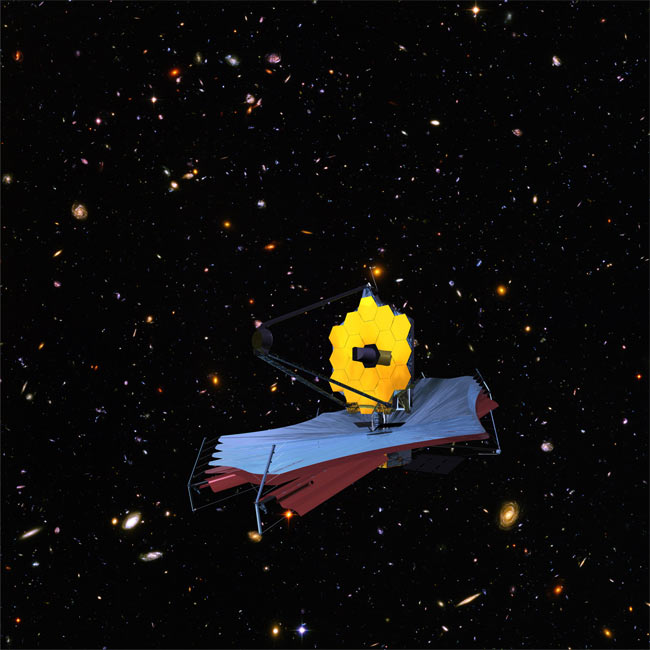Extra Tests May Delay Launch of Huge Flagship Space Telescope

NASA's next-generation spacetelescope — billed as the successor to the Hubble Space Telescope — will likelyneed to undergo extra testing beyond what was previously planned, resulting ina roughly four-month delay that will get worse if Congress does not cover anunrelated cash shortfall the program faces in 2011, according to an agencyofficial.
Phil Sabelhaus, NASA projectmanager for the JamesWebb Space Telescope (JWST), said the additional testing was recommended aspart of a review of the observatory's mission-critical design requirementscompleted in late April. The tests could push the long-delayed JWST's launchdate to October 2014.
Sabelhaus also said the $5billion successor to the Hubble needs moremoney than the nearly $445 million currently requested in 2011 to prevent "furtherslippage to the launch date."
In late April, the JWST StandingReview Board recommended the program conduct additional component-levelverification tests of the spacecraft's massivesunshield and extend the testing of the integrated telescope assembly bythree to four months. The review team also advised increasing JWST's 2011budget to prevent further schedule erosion.
"One of the recommendationsis to ask Congress for additional funding in [2011]," Sabelhaus told SpaceNews May 14. "But all the factors have to be folded in, includingwhether it is practical to think we could get funding in [2011]. If that's notthe case, you may have to go in and look at further slippage to the launchdate."
Sabelhaus could not say how muchmore JWST's price tag is likely to grow, but said additional funding is neededin 2011 regardless of whether the program implements the JWST Standing ReviewBoard's testing recommendations.
Led by NASA's Goddard SpaceFlight Center in Greenbelt, Md., JWST is a hugeinfrared telescope with a 6.5-meter foldable mirror and a deployablesunshield the size of a tennis court. An Ariane 5 rocket provided by theEuropean Space Agency is slated to launch JWST to the second Lagrange point, agravitationally stable spot 1.5 million kilometers from Earth.
Get the Space.com Newsletter
Breaking space news, the latest updates on rocket launches, skywatching events and more!
Sabelhaus said the recent MissionCritical Design Review conducted by the independent review board confirmed JWST'sdesign meets all science and engineering requirements for its mission, thoughits large size makes testing a challenge.
"Given that you can't testthis thing full up you need to do some additional testing to prove the marginsthat you've got are adequate for a successful mission," he said. "Theylike the testing we had [planned], they just think we ought to do more."
However, development of thetelescope, led by prime contractor Northrop Grumman Aerospace Systems of LosAngeles, is turning out to be more complicated and costly than planned.
"We're running a littlehotter these days in trying to get this thing designed and built," hesaid. "We spent some money over the last few years working off some issuesthat were hard problems, and we've gotten to the point where we're probablygoing to need more than we planned on."
The 2011 budget request NASA sentto Congress in February includes $444.8 million for JWST, or about $60 millionmore than the agency previously projected needing. That increase comes on topof the $75 million in American Recovery and Reinvestment Act funds NASA added toJWST in 2009 to avert contractor layoffs.
Jon Morse, director of astrophysicsat NASA headquarters in Washington, D.C., said NASA is closely tracking costand scheduleperformance of the telescope.
"It's especially importantfor JWST to perform well, since it represents the nation's next big advance inspace astronomy research and occupies such a large fraction, about 40 percent,of the overall Astrophysics Budget," he told Space News in a May 13statement. "Additional unplanned delays and overruns threaten to underminethe underlying motives for pursuing complex, new facilities for exploring thecosmic frontier."
Morse said that as NASA evaluatesthe review panel's findings, JWST is still working toward "a summer 2014launch readiness date." However, "the schedule for JWST may beadjusted depending on the outcome of this review," he said.
Sabelhaus said most of the reviewboard's recommendations will ultimately be adopted, "but that is a processthat will take until the late-July timeframe."
- The 10 MostAmazing Hubble Discoveries
- Images— 20 Years of the Hubble Space Telescope
- Bigger,Better Space Telescopes Following In Hubble's Footsteps
Join our Space Forums to keep talking space on the latest missions, night sky and more! And if you have a news tip, correction or comment, let us know at: community@space.com.
Amy Klamper is a space reporter and former staff writer for the space industry news publication SpaceNews. From 2004 to 2010, Amy covered U.S. space policy, NASA and space industry professionals for SpaceNews. Her stories included profiles on major players in the space industry, space policy work in the U.S. Senate and House of Representatives, as well as national policy set by the White House.









